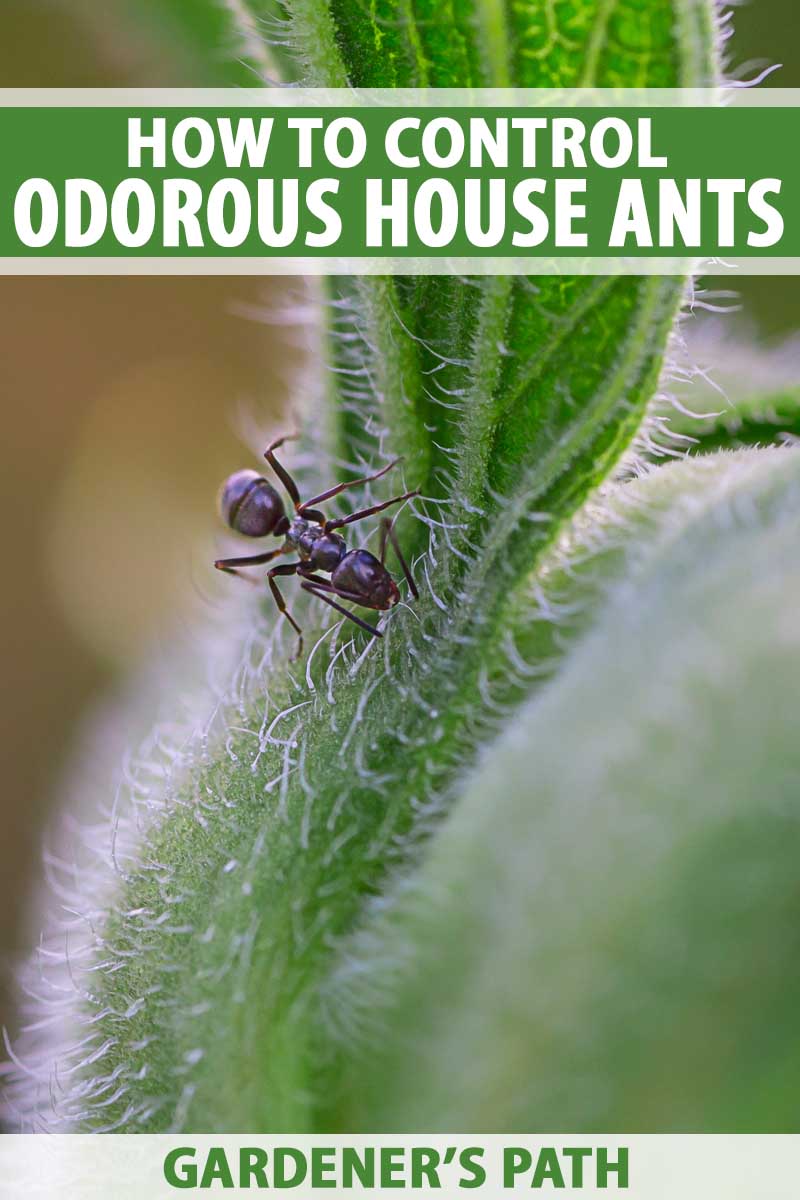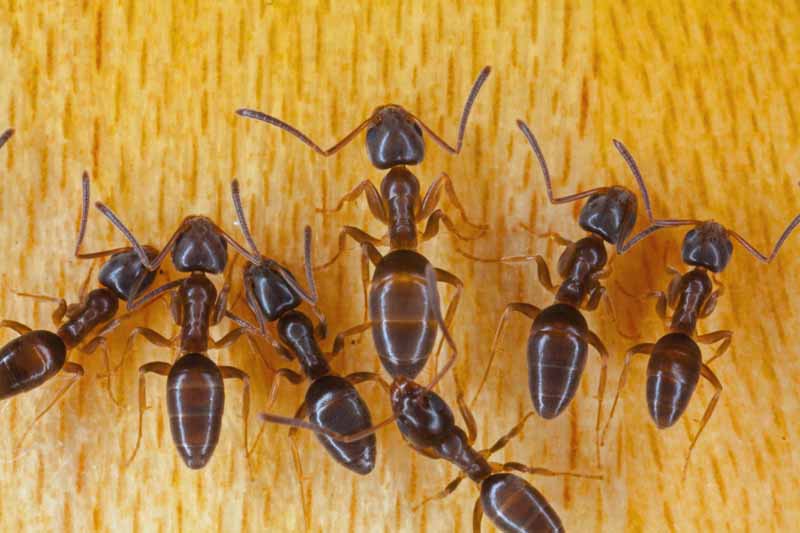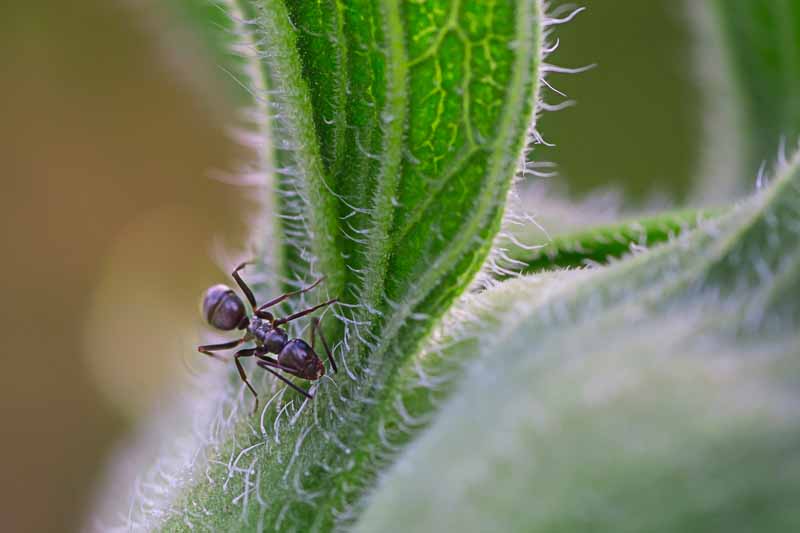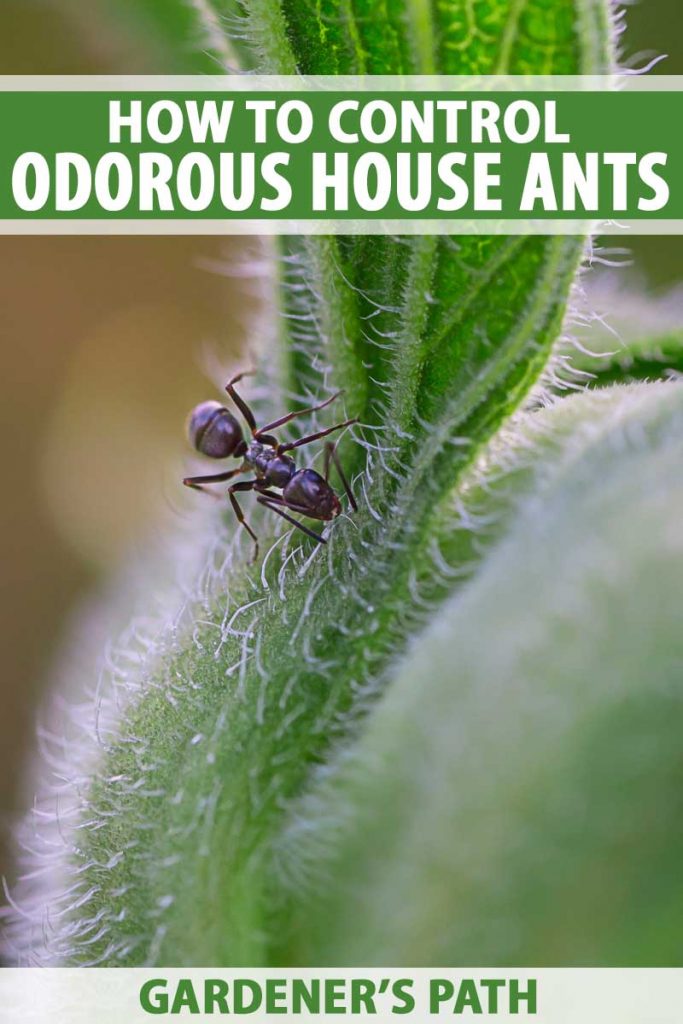Tapinoma sessile
Odorous house ants (Tapinoma sessile) are native to the continental US and are distributed from Mexico to Canada.
These ants eat an unusually broad variety of foods, which often brings them into houses and in conflict with humans. They are one of the most common types of ants found in houses. Odorous house ants can bite, but this doesn’t usually hurt badly.
While they will nest outside, they often enter houses in the fall or when it rains.

We link to vendors to help you find relevant products. If you buy from one of our links, we may earn a commission.
These ants like to nest in warm, moist places in structures – near toilets, hot water heaters, pipes, and drains, and even behind paneling or under carpets!
What You’ll Learn
Identification
Like many ants, odorous house ants are 1/16-1/8 inches long and brown to black. However, they are unusual in not having a cluster of hairs on the end of their abdomen.
Odorous house ants get their name from the distinctive smell they make when crushed – like rotten coconuts. Most ants smell acidic when they are crushed due to their formic acid.
How to Distinguish Odorous House Ants from Argentine Ants
Odorous ants are vulnerable to encroachment by the invasive Argentine ants, which can drive them away.
Both types of ants frequently infest houses. You can distinguish them by the trails of workers. Odorous house ants march in single file, while trails of Argentine worker ants are five ants wide.
The antennae of Argentine ants have eight segments, while those of the odorous house ants have 12.
If you crush the ants, Argentine ants smell musty, while odorous house ants have their characteristic rotten coconut smell.
Biology
The females lay an egg daily, and odorous house ants can take from 34 to 83 days after hatching to develop into adults.
These ants live in large colonies, which can range anywhere in size from 100 to more than 100,000 workers. However, the colonies can have multiple queens, which is unusual for ants.

The ant colonies outside can be in exposed soil or mulch or frequently under bricks, boards, or rocks.
New colonies can develop in two ways. The ants may swarm and move to a new location to establish new colonies, or a queen and workers may spread by “budding” and establish their own colony.
Odorous house ants typically feed on the sugary honeydew secreted by aphids, scales, or mealybugs, although they will feed on insects if necessary. Unlike many other types of ants, these pests will forage night and day.
Colonization of Houses
Odorous house ants can enter your dwelling through openings around doors and windows or cracks in the foundation.
In addition to infesting moist areas of houses, odorous house ants will live in wood damaged by termites.
They typically infest houses when their food supply outside starts running out when the leaves fall in the autumn or when it rains.
Odorous house ants are not fussy! Once indoors, they will eat sugary foods like pastries, meat, dairy products, fruit juices, or cooked or raw vegetables. Because of this, they can be major pests in pantries.
Control
The best way to control odorous house ants is with ant baits. An advantage of using baits rather than sprays is that you are much more likely to eradicate the whole colony.
Another major advantage is that using an ant spray will probably stress the colony, which then is likely to split off into multiple colonies. This will make your ant problem even worse!
Given the preference of these ants for both sweets and meats, you may want to use three types of baits at once: sweets, grease/fats, and protein.
As is standard practice with baits, you do not want to kill the ants too quickly. You need the ants to take the bait back to the nest to kill the queen and her workers.
Slow-acting insecticides that work well in baits include boric acid, fipronil, or hydramethylnon.
Place the baits where you see ant trails, since they are traveling back and forth between food sources (i.e., your house) and their nest.
Some sources advise against using baits inside because that can draw more ants into your home. However, if you have an infestation in the fall when it is cooler, you would be well advised to use indoor ant baits.
Highly Invasive Native Ants
Odorous house ants can form colonies of more than 100,000 workers and are one of the primary types of ants that invade houses in the continental US.
What makes these ants particularly troublesome is that they eat foods ranging from sweets to meat and dairy products. This makes them major pests in kitchens.
You can control an infestation by using the proper kind of ant baits.
Have you fought off an odorous house ant infestation? Let us know how you fared in the comments.
Learn more about different ants and how to control them with these guides:
© Ask the Experts, LLC. ALL RIGHTS RESERVED. See our TOS for more details. Uncredited photos: Shutterstock.


I almost lost my kitchen to these in 2016, lol! I had just come clean from a 7-year heroin addiction and finally noticed them everywhere!!! Tons of pesticide sprays and a flea bomb is what worked for me. Saved me and my kids from these little creatures!
Hi Antfreenclean93,
Congratulations on your recovery! I’m glad that you got creative with the infestation and was able to cure it. Those kinds of ants can have their nests in houses, and I wonder if that was the case with you, since the pesticides worked to get rid of them. Hopefully, you will stay ant free!
I struggled against an infestation of these ants in my previous house. They were well established in the area and despite using multiple bait stations over months/years in my kitchen and outside I doubt that I even made a dent in the local population. And the smell! What an unpleasant experience it is to accidentally crush one. The local spiders wouldn’t eat them and I can imagine that their odor is enough of a deterant that have few natural predators. I had them go after items that most ants wouldn’t even consider trying to eat. This included things like the… Read more »
Hi Alexis, oh my goodness that sounds like a terrible infestation!
Absolutely horrid pests. The ones I have will not take bait of any kind and no amount or kind of poison keeps them from pouring into the house. They have several trails up the foundation. They aren’t bothered by cinnamon or strong herbs, they eat cough drops, and they are so small I even found them in a SEALED jar of sweet relish! It popped when i opened it! Everything has to go in ziploc bags, and to keep them out of the pet bowls I have to put Vaseline around the edges. They make huge nests on my walls… Read more »
That sounds awful Ashe! Have you thought about potentially seeing if a professional exterminator could take care of the problem for you?
We moved into this rental house on May 17th and noticed with in 24 hours all the ants. We thought we brought them in due to putting down cat food. So we offered to pay for the exterminator instead of the landlord. The exterminator has been here 4 times in 6 weeks. Its the middle of summer and you guys say they are most active in the fall? Not looking forward to that. They are mostly in our shower stall which the exterminator says it wouldn’t do any good to spray, for obvious reasons. However 24 hours after taking a… Read more »